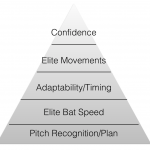The way we teach vs. The way they learn
How many times have you spent what seems like forever meticulously introducing, going over, or reviewing a topic only to turn it over to your athletes and they are unable to execute what you just taught them? Frustrating isn’t it?
Another scenario we have all seen is, we introduce a technique or tactic and they “master” it during a drill in practice. We get to our next game, the exact scenario we just covered arises and they fail to execute. At this point we assume it is the players fault since we “taught” it to them. Right? Wrong! It doesn’t matter what we teach our athletes, it only matters what the athletes learn. If an athlete gave an honest effort during practice and did not learn what we taught them, then we need to take a closer look at our methods.
Rome was not built in a day
Sometimes what we teach the athletes is sticking, but we get impatient because they cannot immediately transfer what they did in practice to competition. When put in situations of stress (competition) athletes will revert to what is natural and what is most comfortable. It takes time (and correct reps) for new techniques to take hold. Be patient!
Appeal to a wide variety of learners
A good teacher in the classroom will carefully craft their lessons to meet the needs of auditory, visual, and tactile learners. Teaching by having athletes explore a skill, then answer questions about what they did is a good way to incorporate tactile and auditory learners. Visual learners can be reached by having another athlete (or coach if necessary) demonstrate the skill correctly.
In reality most of your athletes will learn best when the information is presented in a variety of different ways, however if you can learn which of your athletes learn better by which method, you will increase your chances of reaching them.
Use technology
Many players have not ever seen themselves on video. With technology being readily available to so many of us, it makes sense to use it to our advantage as coaches. The simplest way to use technology is to video athletes attempting the skill, and playing it back for them to critique. This method will reach visual and tactile learners very well. Combine the video with a verbal critique of what they can to improve and you have now reached all three types of learners.
A more advanced way to teach with technology is to post videos on a website or blog, or send athletes the URLs of videos you want them to view. The videos can be of you teaching a skill, of an athletes performing the skill, or any other instructional video you find on the internet. They can view these videos at home and come to practice prepared to discuss the video and try the techniques. This method also reaches all three types of learners.
Cornerstone offers a complimentary video analysis that will provide coaches and players with visual, verbal, and written feedback on any skill they choose.
Have them teach someone else
Think about how much more you understand about the game of baseball now that you teach it. Coaches have the ability to give their athletes a taste of this by having them teach techniques their teammates, or to a younger team (I do this every Friday when we have our Sophomore team practice with our Varsity). This will not only give your players a deeper understanding of what they are doing, but it will give them ownership over the technique they are teaching.
If you want to get more advanced, have your athletes go home and view a video of your choosing online. Tell them to come to the next practice ready to teach what they saw in the video their teammates. Allow them to use notes if necessary.
Summary:
Being an athletic coach is not unlike being a classroom teacher. If teaching and coaching were as simple as telling people what to do, anyone could be a a great teacher and coach. The real art of coaching lies in the effectiveness of conveying your message by any means possible.
The above post is a small example of what you will find in Cornerstone's full site membership.
Check Out Our Membership Options
More from my site
 Mini – Pound the ball into the ground
Mini – Pound the ball into the ground To Bunt, or not to Bunt
To Bunt, or not to Bunt CCA Podcast 119: Components of a great outfielder
CCA Podcast 119: Components of a great outfielder CCA Podcast 233 – The Hitting Pyramid – Pitch Recognition
CCA Podcast 233 – The Hitting Pyramid – Pitch Recognition CCA Podcast 033: Making Pitcher Practice More Effective Q&A
CCA Podcast 033: Making Pitcher Practice More Effective Q&A CCA Podcast 204 – Dirt ball reads, base running efficiency, and taking over a program
CCA Podcast 204 – Dirt ball reads, base running efficiency, and taking over a program
 Posted by Kyle Nelson
Posted by Kyle Nelson- Posted in Uncategorized
 Dec, 29, 2012
Dec, 29, 2012 3 Comments.
3 Comments.
Elite members login here
Check out what’s New/Hot!
Recognizing, Diagnosing, and Fixing Common Hitting Flaws eCourse The 3 metrics we tested on Blast motion sensors this year Sneak Peek Inside an Elite Q and A The batting practice continuum Elite Member’s area table of contents 50+ “Chaos” hitting drills
5 sample Chaos hitting drills FREE
Mental Skills and Culture Building The hitting pyramid Welcome Elite Member, Trey! Ideas for a pitcher first practice 12 week bat speed improvement plan Make plans this offseason to have your team playing their best baseball at the end of the year” Top 5 hitting drills to translate practice skill to game performanceHow we used Blast Motion sensors with a team in 2019
What to do if your hitters are overmatched Welcome Elite Member, Tommy! Setting your baserunners up for success Welcome Elite Member, Mike! A consulting call with Elite Member Matt FREE Web Clinic: Developing Athletic, Consistent, Extraordinary Infielders
 Coach Kyle Nelson
Coach Kyle Nelson
Great article! I also think by having your team teach we of the drills gives them ownership if something breaks down during the games. It will make them want to prove more. It is a step toward building leaders on and off the field. Nice Work!
http://www.Twitter.com/bsftraining
Mike- Building leaders on and off the field should be one of the top priorities for any coach. Thanks for reading and thanks for the feedback. Have a great 2013!
Kyle
[…] How many times have you spent what seems like forever meticulously introducing, going over, or reviewing a topic only to turn it over to your athletes and they are unable to execute what you just taught them? […]